What is a SWOT analysis? Tools to help improve your business
Setting up a business is hard work, but keeping your business performing successfully is an even bigger challenge, year on year. Keeping your team engaged, and communicating clearly can be a huge challenge – even if you’ve got a great team and sound technology solutions. Luckily, there have been plenty of tools created over the years that can help you to identify any potential issues with your business, and to give you ways to eliminate, or minimise such issues.
In this post, we’re going to take a look at some of the most popular business analysis tools that you can use to take your business to the next level. Perhaps you need a tool to look at data that helps you assess the current state of play, or to analyse what you need to do next. Maybe you need to identify small problems to prevent them becoming huge stumbling blocks that will cost your business time or money.
Since many of the tools for analysing your business are created by theorists, there’s going to be a lot of acronyms in this post. We know some people don’t like this kind of thing, but if you put aside the thought that it’s all utter nonsense (feel free to use any other word you prefer in place of nonsense!) these tools can really be valuable to your business. And remember, nobody needs to know you’re using theoretical business nonsense to get ahead – you can keep it as your own secret weapon!
SWOT analysis
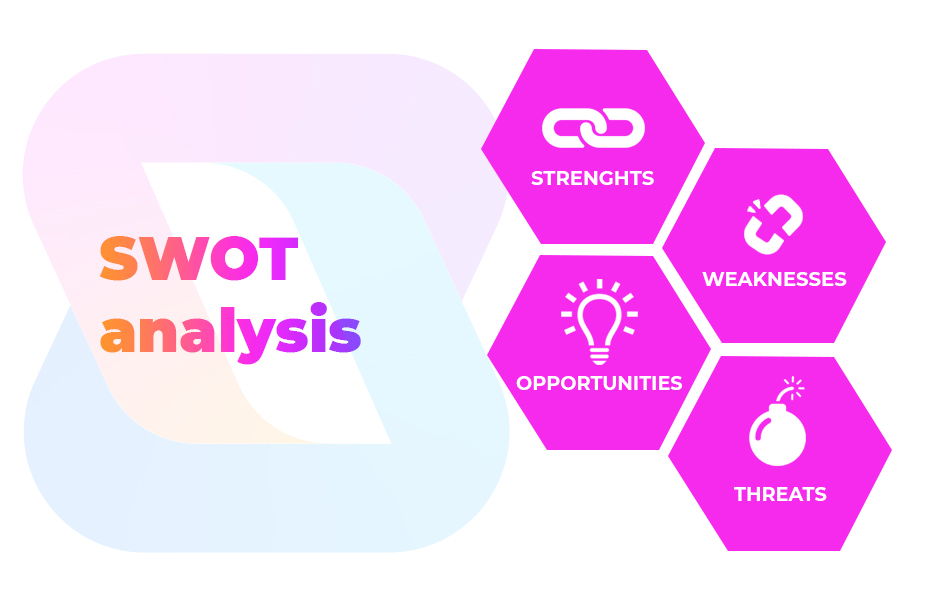
Normally, when we introduce an idea, we’re usually able to accredit it to someone. Although there are many major theorists in the world of business that are associated with, and use SWOT analyses, it is unclear who initially proposed the idea of a SWOT analysis. Many academics credit the test to Albert Humphrey, but he never claimed the creation of SWOT. Whoever came up with the test, they deserve a round of applause – since it really is a useful way to assess what is going on with your business, and work out what action you need to take next.
What does SWOT stand for?
SWOT stands for Strengths, Weaknesses, Opportunities and Threats.
What does a SWOT analysis do?
It’s a little bit like writing a more advanced version of a pros and cons list – but with more of everything good and bad. You can use a SWOT analysis to help you measure many different elements of your business, but essentially, a SWOT analysis looks at what the perceived strengths, weaknesses, opportunities and threats to your business – or a decision you’re making about your business. Once you’ve done a SWOT analysis, you’ll be able to use the information to create an action plan that will help you ensure
Who should be involved in doing a SWOT analysis?
You might think that business tools should only be used by the people in charge. But in reality, you’ll do much better if you’re including everyone that is involved with your business – because you’ll all see what could be SWOTs from different perspectives. In addition to people within the company, you might invite an outsider or two in – that might be from your clients, a mentor, or someone from a company that you partner with, like an account manager from a logistics company. The more ideas you have about what issues are SWOTs, the more likely your analysis will be a success.
When should you do a SWOT analysis?
It depends on what you want to achieve from your SWOT analysis, and what your needs are. A SWOT analysis can be really useful before setting up a new business like DropShipping, or when you’re assessing a DropShipping platform. But generally businesses find success when they carry out a general SWOT analysis twice a year or so, but also when there is a significant decision to be made.
Aside from doing a periodic general assessment of your business, times you might use a SWOT analysis are such as when you’re making plans for marketing activities, when you’re changing operational plans or making a key hiring decision. You might also look at the current state of the market – such as when there has been a downturn in the economy due to world events, or when we’re approaching quarter four, when retail sales are typically at their highest.
How do you conduct a SWOT analysis?
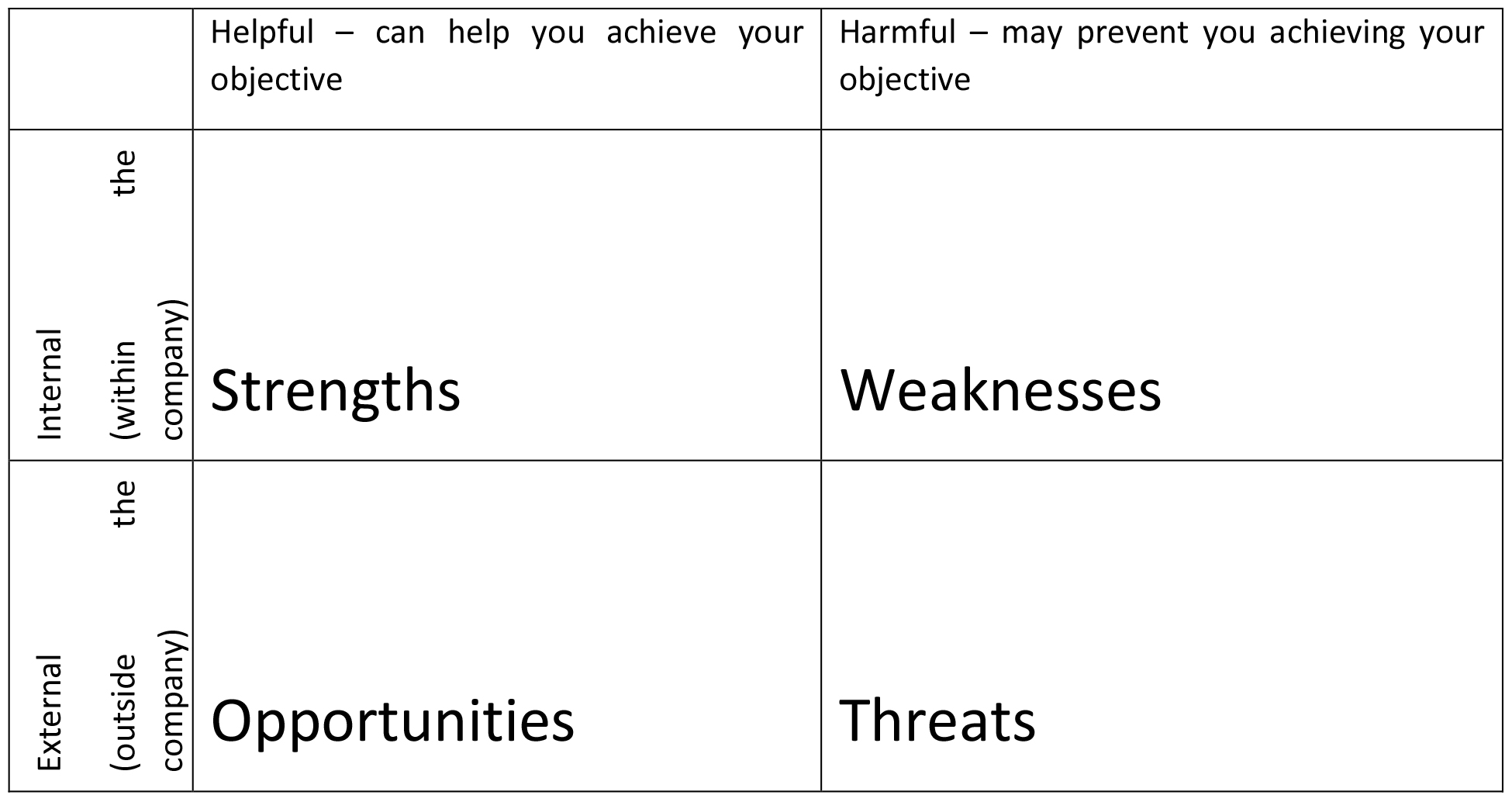
Many people like to lay their SWOT analysis out in a grid, like this. But depending on what you’re conducting your SWOT analysis about, this might not be useful. Using four different sheets of A4, carrying it out in Word (so you can change things easily) or OneNote using a template – they’re all totally fine.
The key to a successful SWOT analysis is being thorough, and being completely honest. You might already know where the issues are within your company, but sometimes acknowledging the elephant in the room can be hard, because making a change to resolve the issue is going to be hard. Your SWOT analysis should help you face up to the weaknesses and potential threats you face without judgement or blame, so you can work past them and be successful – either in spite of them, or because of them.
What goes in each box?
Strengths are the good things about your company, or the decision you’re about to make. Things that go in this box are within your control, and you feel positive about. Strengths can include something along the lines of your physical assets, a strong relationship with your business partners or it could be a competitive advantage that you have compared with other businesses.
Weaknesses are all the negative things about your company or decision. They’re things that you know you need to improve on, or have identified as having potential to be better than they could be. It could be a process, a training need or maybe a cashflow problem.
Opportunities are factors outside of your business that might support your business continuing to be successful, or will contribute to the success of the decision you’re making. Ideas that might go in this box could include the current state of the market, industry events that you might be attending and how your customers see your business.
Threats are just what they sound like – something outside of your business that you can’t control. This might include things like whether your suppliers can meet your needs, your competitors, or your technology solutions. Don’t forget your customers and market conditions – they’re all things that you may need to plan for. Identifying threats can help you create contingency plans for if the worst happens, and can help you to minimise the impact of your threats if conditions remain optimal.
If you’re stuck trying to think what should go in each box, try asking questions using who, what, why, when, where and how to get you started. This feel like an incredibly basic way of getting started, but that doesn’t matter – the easier it is to get going, the more effective your analysis can be.
What do you do after you’ve completed your SWOT analysis?
There’ll be the temptation to stick your grid up on your noticeboard and glance at it guiltily now and again as things go on exactly as they were before – we’ve seen it happen in many different businesses! Once you’ve completed your SWOT analysis, you need to take the learnings from it and apply them to your business. You’ll be creating an action plan, so that your business can get the real value from the exercise and grow accordingly.
You’ve completed your SWOT to make the best of everything, so make sure to look at your strengths and opportunities first. Are there any ways that you can use these to combat any weaknesses or threats? Once you’ve identified how to combat your weaknesses and threats, you’ll need to set goals. It’s a good idea to keep your targets SMART – Specific, Measurable, Achievable, Realistic and Time-bound. Put them on your calendar, and keep to the deadlines you’ve set, and you’re more likely to achieve your goals!
PEST analysis
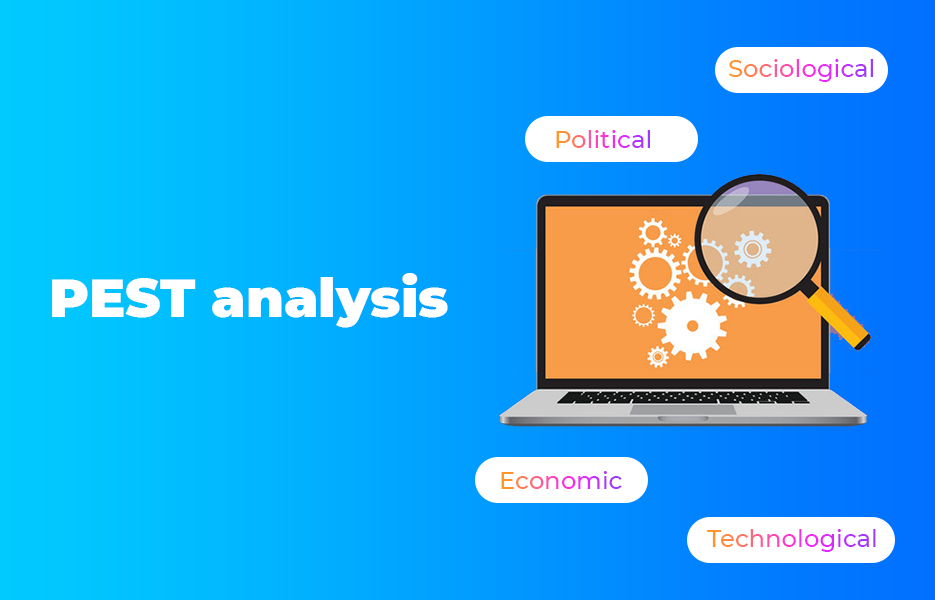
A PEST analysis is a business model that can help you get to grips with the opportunities and threats from your external business environment. It’s about looking at the bigger picture outside of your business, like new technology, new customers that you might be able to access, and new funding opportunities or government policies. PEST analysis has been around since the 1960s, and has been accredited to Francis Aguilar, who was a professor at Harvard, and he initially called it EPTS in his book Scanning the Business Environment.
What does PEST stand for?
PEST stands for Political, Economic, Sociological and Technological. There are variations of the test that include PESTLE (adding in legal and environmental factors), STEPE (adding ecological factors) DESTEP (including demographic and ecological factors) and SPELIT (adding legal and intercultural factors). You can also consider STEER, which excludes political factors, and looks at sociocultural, technological, economic, ecological, and regulatory factors.
What does a PEST analysis do?
PEST analysis is designed to help businesses for four main reasons:
- To help identify opportunities – either personal or business – and to help identify significant threats in advance.
- To help identify the direction of change within your business. This allows you to use the change as an advantage, rather than as a problem. It’s easier to go with the flow, rather than against it!
- To help identify projects that are at greater risk of failure because of factors that are outside your control.
- To help identify unconscious assumptions when you’re working in a new country, region or market. A PEST analysis will help you see the new environment more objectively.
Isn’t this just like a SWOT analysis though?
In a way, it can be thought of as a similar tool, but it is the focus of what is being analysed that is the major difference. SWOT is used for individual, product, or business level, whereas PEST is used for the bigger picture factors that can influence whether to make a decision, such as entering a market or launching a new business.
You can potentially use a PEST analysis alongside a SWOT analysis. For example, you might use a PEST analysis to decide whether to create a new business, and then use a SWOT analysis to look at the business in more detail.
Who should be involved in a PEST analysis?
PEST analyses are looking at factors that can influence strategic decisions, and so generally managers and staff that are responsible for managing change should be involved in carrying out a PEST analysis, but you’ll need to determine who would be the most appropriate for your business. If your business only employs a few people, you might decide to involve everyone. Bigger corporations may carry out PEST analyses at different levels, from senior management teams, to heads of department.
When should you do a PEST analysis?
Although it is completely up to you (and the needs of your business) when, and how often you decide to do a PEST analysis, there are a few key times that a PEST analysis are more appropriate than others.
When you’re launching a business is a logical time to carry out any kind of business analysis – we’ve already mentioned this. The PEST analysis (or any of the appropriate variations), combined with a SWOT analysis will help you avoid any potential pitfalls.
When your business is facing a problem, a challenge or an issue is also a good time to complete a PEST analysis. If you’re looking at a problem in one area, there’s a good chance that you’ve got other issues too. Although you might want to rush to take action to resolve those issues, taking a bit of time to complete a PEST analysis can help you uncover these issues. You might find things are better – or worse – than you had feared, but since you’ll have the information, you’ll be much better equipped to take action to move past the problem.
There are some bad times to carry about a PEST analysis too though, so don’t jump straight in. Stop and think about the issue, and decide if you’re going to get the best outcome from the tool. For example, if you’re encountering communication issues, or conflict between staff, PEST isn’t the tool to help you fix the issue. (There is plenty of expert advice online about resolving issues between employees – this article from Forbes is a great place to start!) Similarly, think about the timing of when you’re considering a PEST analysis. Right before you launch a new product – as in, less than a week before – it’s too late. You’ll already be in too deep at this point, so make sure you’re using your PEST analysis with enough time.
How do you conduct a PEST analysis?
Like with a SWOT analysis, you might find it useful to create a table, or to use different sheets of paper while you’re conducting your PEST analysis. Flipchart paper and post-it notes can be an easy way to allow people to be involved.
| Opportunities | Threats | |
|---|---|---|
| Political | ||
| Economic | ||
| Sociological | ||
| Technological |
Since your PEST analysis is looking at much bigger issues, you might need to be prepared to take longer than with a SWOT analysis.
Political factors look at the impact the government – either local or national – has on your business. So, you might think about how stable the political environment is right now, when another election is due and if, when the election happens, you expect the ruling party to change. You’ll want to consider taxes, competition law and whether there are any policies, either at local or national level that will impact on your business. Not all of these will be threats, of course, but you’ll need to consider everything that could have an impact on your business.
Economic factors are concerned with the general economy. So you’ll need to look at whether there is a chance of recession, whether interest rates or inflation are likely to increase. You’ll also need to look at how easy it is to get credit, especially if that is in your longer-term business plan (or may need to be). If you’re doing business overseas, how stable are the currencies in each country, and what are the exchange rates like. Finally, it’s important to think about the potential for changes in disposable income – which might also impact unemployment rates.
Social factors are quite hard to predict – so you’ll need to look at, and carefully assess demographic factors. Look at the levels of education, lifestyle preferences and trends, religion and family relationships. Considering these will help you to determine moral and ethical concerns of the population, retirement ages and how important issues such as environmental issues are to the population, and of course, your staff and customers.
Technological factors are perhaps some of the biggest issues you’ll need to consider. In the past few decades, technology has evolved at an astonishing rate – and it is unlikely that this will stop. You’ll need to consider how new technology will impact on your business, and what you might need to do to keep up with it – since your competitors are likely to be doing so. How will technology impact your business partners, and their operations? And what are your plans for obsolete technology?
What do you do after you’ve done a PEST analysis?
As you complete your analysis, you’ll need to identify the most important issues. Your action plan from there will depend on your strategic requirements. So, you might need to complete more research, compile a report or feed the information into a bigger strategy, depending on why you did the analysis.
You should avoid using a PEST analysis as a one-off exercise though. Like the SWOT analysis, you’ll get the most from the business by completing PEST analyses regularly – although you’ll know what the right time frame for your business is. It might be a monthly, quarterly or twice-yearly event.
MOST analysis
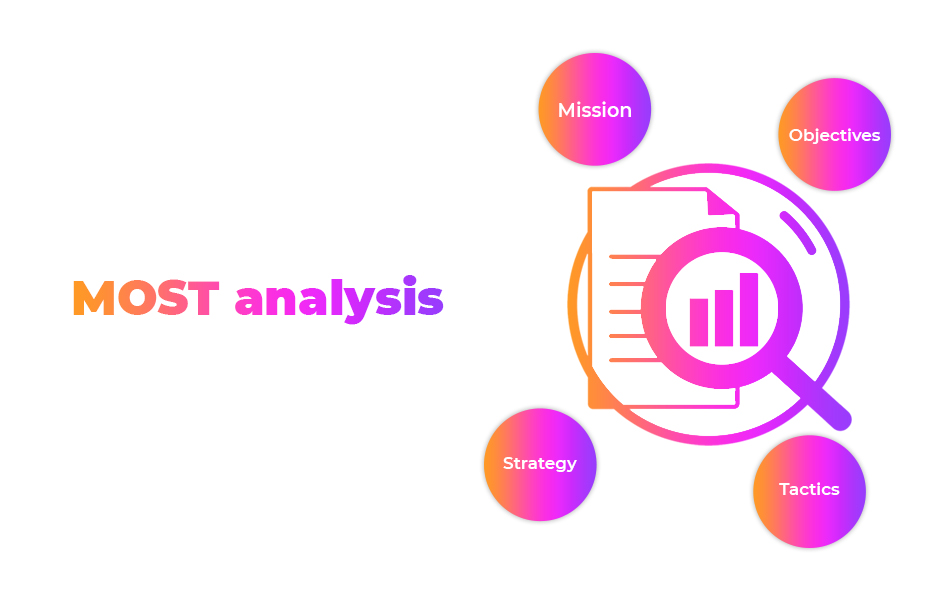
Generally accredited to Rakesh Sondhi, the MOST analysis is a simple framework that businesses can use to inform their overall business plan and tackle their goals for the business aside from ‘to make money’. The MOST analysis helps organisations be much more specific about what they want, and need to do to meet their expectations.
What does MOST stand for?
MOST stands for Mission, Objectives, Strategy and Tactics. There are other variations that include VMOST – to include Vision.
What does a MOST analysis do?
A MOST analysis can help an organisation to understand the purpose of their existence, and it can be an incredibly powerful way to help empower businesses, charities, clubs and any other kind of structured organisation. It can help turn a vague – or even a strong – vision into realistic and achievable goals, to provide motivation and to help the organisation to reach the next level.
Who should be involved in a MOST analysis?
It really depends on your organisation. If you’re a small business, we’d recommend involving all of your staff, but larger businesses might find it a more valuable experience if only a few strategic team members are involved.
When should you do a MOST analysis?
Clearly, as you are launching a business is the most logical time to complete a MOST analysis. However, if you’re at a crossroads of your business, or you find that your business has evolved, you might decide to conduct a MOST analysis. It can be valuable to conduct a MOST analysis periodically, to ensure the team are on board with the findings and that the findings are still appropriate for the aims of your business.
How do you conduct a MOST analysis?
The MOST analysis is a relatively straightforward process to carry out. First, you’ll need to establish the scope of what is being assessed. Are you going to analyse the whole organisation, a particular team or department?
Mission looks at the purpose of the business plan for the business. It’s the pinnacle reason that you’re in business, in terms of what you’re attempting to accomplish. Therefore, the more exact you can be in defining the mission, the more likely you’ll be successful when defining the other points in your MOST analysis, but also longer term. The following points will be what will help you meet the mission.
Objectives are the next things to set. These are the individual goals that will ensure you and the team will be able to meet your mission. Again, the more specific you can be about what makes up your objectives, the more successful you’ll be able to be. Make sure your objectives are measurable, and note how you are going to assess them after a set amount of time, so that you can determine whether you have met the objectives.
Strategy are the tasks that help you to meet your objectives. There are huge differences in the types of strategies that businesses can use – you don’t have to use the same as other businesses – but your strategies should support your objectives. So, if you set an objective of increasing sales by 10% within a set period as an objective, you might look at promotions, advertising activities or rewarding repeat customers as strategies. As with the mission and objectives, you should be as clear as possible, so make sure your strategies are specific and actionable.
Tactics are the exact things you’ll do to meet your strategies. So if you decide that you’re going to increase social media marketing, your tactics might include things like ‘design campaign tagline’, ‘research and decide on the hashtag’ and ‘post to Facebook and Instagram daily’.
What do you do after you’ve done a MOST analysis?
Sharing your findings with all of the team – especially where some team members weren’t involved – is an important first step. Then, start from the bottom up, ensuring that each of your tactics are allocated to team members, and that your deadlines are implemented, so that your strategies and objectives are met. This in turn will help meet your mission.
Six Thinking Hats

The Six Thinking Hats model was created by Edward de Bono in 1985. Each metaphorical ‘hat’ is designated a different colour, representing a different perspective. You don’t need actual hats for this theory though (although this writer loves a good hat, so feel free to use your hat collection if you have one!) – the hats are metaphorical to help you think about things in a different way.
What do the Six Thinking Hats do?
The Six Thinking Hats is a tool that can help you with decision making. It’s designed specifically to help you to look at problems or opportunities from different perspectives. It can be a valuable tool if you’re naturally cautious, or if you tend to be a bit more reckless, but it’s useful for ensuring you consider the decision from all perspectives.
Who should be involved when using the Six Thinking Hats?
It really depends on what you need to achieve, or decide when you’re using the Six Thinking Hats. You can use the Hats way of thinking when you’re looking at something individually, or you can use them together with your team. In a team situation, it can be really useful to help avoid confrontation, since it allows people to get their perspective across much easier, and without judgement at the appropriate time.
When should you use the Six Thinking Hats?
You can use the Six Thinking Hats any time there is a decision to be made. Of course, you aren’t likely to need the Six Hats for every decision you need to make for your business – the Six Thinking Hats are for major, or difficult decisions. It has potential to be used alongside other tests, so if you’re conducting a SWOT or PEST analysis before deciding whether to launch a new business, to enter a new market or to add a new range of products, definitely consider the Six Hats.
What do the Six Thinking Hats colours represent?
White hat is where you focus on the data available to you. This might mean you look at statistics that are currently available, or that you assess current or past trends to help identify lessons that can be learnt.
Red hat is where you look at the decision, or the problem through the perspective of your intuition. If you have a gut feeling about something that is yet unfounded, this is the point at which to air it. If someone doesn’t understand at this point, or believes someone to be illogical, encourage understanding. The red hat doesn’t have to be logical, because it is about emotions.
Black hat is where you take a look at the decision’s problematic outcomes, or potentially negative issues that go with it. Think about what might not work – even if you think the decision is a good one, there may be challenges or risks to overcome to get the optimum results from it. This approach can help you increase the resilience of your plans, because you’re more likely to have spotted problems ahead of time, and have prepared contingency plans or taken action to counter the problem.
Yellow hat is where you think positively about the decision, or the issue. Being positive about the decision will help you to identify the benefits, or value of the issue. If there is a lot of doom and gloom about the decision, thinking with your yellow hat can help you, and the team to feel more positive.
Green hat is where you, or your team think in a creative way about the decision. If there are problems to overcome, using green hat thinking can help you to come up with a way around them. No idea is too silly in green hat thinking – because even the most outlandish idea may trigger the best solution.
Blue hat is where the control is. If there is more than one person involved in the decision, the person ‘wearing’ the blue hat controls the proceedings. Blue hat is where the decision to move into a different colour hat starts – for example, if there are few ideas forthcoming, then they may change the hat to green, or if there are absolutely no thoughts, to red.
How do you use the Six Thinking Hats?
Since the Six Thinking Hats is a theory rather than a structured test, so you can use it whenever, and however you like to help you consider different decisions. All you need is to be aware of to use the Six Hats is which colour correlates to which way you need to think about the decision.
If you’re using the Six Thinking Hats with your team, you might want to take notes of the different approaches – either using a mind map on a whiteboard, on grids on flipchart paper or simply by taking notes individually – so you can use all the information when you’ve got to the end of the exercise.
If you’re using the theory for a decision by yourself, then you might use the Six Thinking Hats as a way to structure your thinking – especially if you’re writing it down. You might decide not to write down your outcomes for each hat, but it’ll probably make things much clearer if you do.
What do you do after you’ve used the Six Thinking Hats?
This is entirely up to you, and the reason that you decided to use the Six Hats in the first place! Hopefully though, the theory will have helped you to determine whether you are going to proceed with the action you were going to take or not. Since each of the Six Hats helps you look at the decision with different perspectives, it should also help you to highlight the issues you may need to instigate action for.
MoSCoW analysis
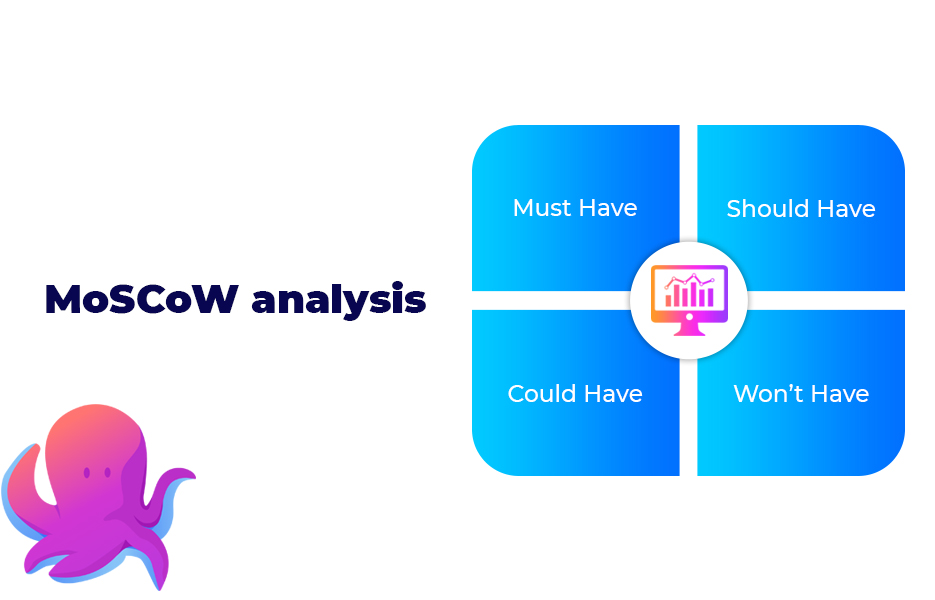
A MoSCoW analysis is also known as MoSCoW prioritization or MoSCoW technique. It’s a framework that was created by Dai Clegg. It is generally used in Agile project management and software development companies, but the principles can be useful for helping any business to prioritise tasks.
What does MoSCoW stand for?
MoSCoW stands for Must Have, Should Have, Could Have and Won’t Have (or Would Like to Have). These are used as headings for groups of tasks.
What does a MoSCoW analysis do?
A MoSCoW analysis is designed to help businesses to prioritise their tasks within a project, business or trading period.
Who should be involved in a MoSCoW analysis?
Managers are the main people that are involved in MoSCoW analyses, but if your business has a small team and everyone is involved in the project, you might bring everyone into the exercise to ensure nothing is left out.
When should you do a MoSCoW analysis?
Generally, you’ll want to do a MoSCoW analysis ahead of starting a project, but you might also use the technique for planning particularly busy days in your business.
How do you conduct a MoSCoW analysis?
Your MoSCoW analysis will help you to lay out your tasks in order of priority. So, you’ll have a list of tasks, and you’ll assign each task to one of the four headings.
Must Haves are the minimum requirements that your project needs to be successful – they’re absolutely non-negotiable. So you’ll look at the target date, and the tasks that must be completed in order to deliver by that date. Your project might not be legal, or safe without the tasks to be completed, or will not meet the requirements of the project without completing those tasks. If you ask the question “what happens if this isn’t done” and the answer is “the project fails”, then that task needs to be in the list of Must Have tasks.
Should Haves are the tasks that are important but not critical to your project. Your project could be a success without them, but in an ideal situation, you will complete them. You might need to find a workaround, or alter expectations if items on the Should Have list aren’t completed on time.
Could Haves are the tasks that you want, or would like to complete as part of this project. If the tasks on your Could Have list aren’t completed, you’ll still be able to complete the project, and there will be less impact if they’re left out.
Won’t Have are the tasks that you know you won’t be able to complete as part of this project. It’s a good way for you and your team to know what isn’t a priority right now. Some of the tasks in this group might move into the Should Have, or Must Have lists as part of future projects.
If you’re using Would Like to Have instead of Won’t Have, then you can add tasks that you think you could complete if everything runs more smoothly than expected, or you might simply use this list as a reference before you start your next project.
What do you do after you’ve done a MoSCoW analysis?
Once you have established which are the most urgent tasks, you’ll be able to use the information to start prioritising further, setting deadlines and allocating workload between your team members. Depending on how long your project is, you may be setting time or date deadlines – but if you’re setting date deadlines, be clear about when on the date the task needs to be completed by. If the deadline date is the third, and the team member thinks they have until end of day on the third, but another team member required it to be done by the start of the day on the third, your team might end up not being able to meet the overall project deadline.
Five Whys

The Japanese inventor and industrialist Sakichi Toyoda established the Five Whys approach to help find the nature of problems, and to find solutions. The history is that the Toyota Motor Corporation used it to help evolve their manufacturing methodologies. It’s been widely applied to other manufacturing and business methodologies due to the simplicity of the method.
What does a Five Whys analysis do?
A Five Whys analysis helps you to find the root cause of a problem within your company. By finding the root of an issue, you’ll be able to take meaningful action that will help you solve the issue and to move forward more effectively.
Who should be involved in a Five Whys analysis?
The Five Whys analysis technique can be used by anyone – from individuals to whole teams. The key to using a Five Whys analysis successfully in your business though, is to ensure you involve people who are stakeholders. They’re the ones that will have the most insights, which will lead to the most
When should you do a Five Whys analysis?
You can use the Five Whys analysis at any time that you encounter a problem that is detrimental to your business. It’s an incredibly simple tool, and can be applied without documenting it. Some parents even apply this technique to their teenage children!
How do you conduct a Five Whys analysis?
It’s pretty simple to carry out a Five Whys analysis. Get your team together, especially members of the team that are involved with, or have influence over the issue you need to resolve. Next, you’ll need to set out the problem clearly, and with as much focus as possible so that everybody is clear exactly what this Five Whys analysis is going to look at.
Put someone in charge of the whole process. That person should help to keep the team on track, and remind the team to stay focused on facts and data, rather than dealing with emotional opinions.
When the exercise starts, you’ll ask why the problem started. An example might go something like this:
Why was the new website not launched on time? Because major changes to the design were requested by the client at a late stage.
Why were the changes accommodated? Because the project manager approved the changes.
Why did they approve changes at this stage? Because they are new to the organisation and didn’t know the protocol.
Why didn’t they know this? They had not yet received the company training.
Why were they managing projects before receiving company training? Because Joe was on sick leave and nobody else was available to cover.
As you can see, the problem wasn’t caused by lazy website developers, or a technology failure, but one of training. Although initially it seemed that the project manager was at fault for allowing the changes, the root of the issue was two-fold – they hadn’t had the training, and the company was short of other project managers that had already received the training, due to Joe being sick.
This allows the team to make changes to how quickly training is received, and to create contingency plans for when there are project managers absent.
If you’re documenting the Five Whys exercise, or need to disseminate the information after the event, there are two common techniques for doing so – a fishbone (Ishikawa) diagram, or in a table format.
What do you do after you’ve done a Five Whys analysis?
Once you’ve found the root cause (or causes) of the issue, then the team should then discuss proposed solutions. Once this has been determined, a team member should be designated as responsible for overseeing the implementation of the required actions.
After a certain amount of time, the group should reconvene to evaluate whether their actions resolved the issue, and if there are any lessons to be learnt. If the actions have not resolved the issue, the process may need to be repeated.
I hate these acronyms – can I create my own?
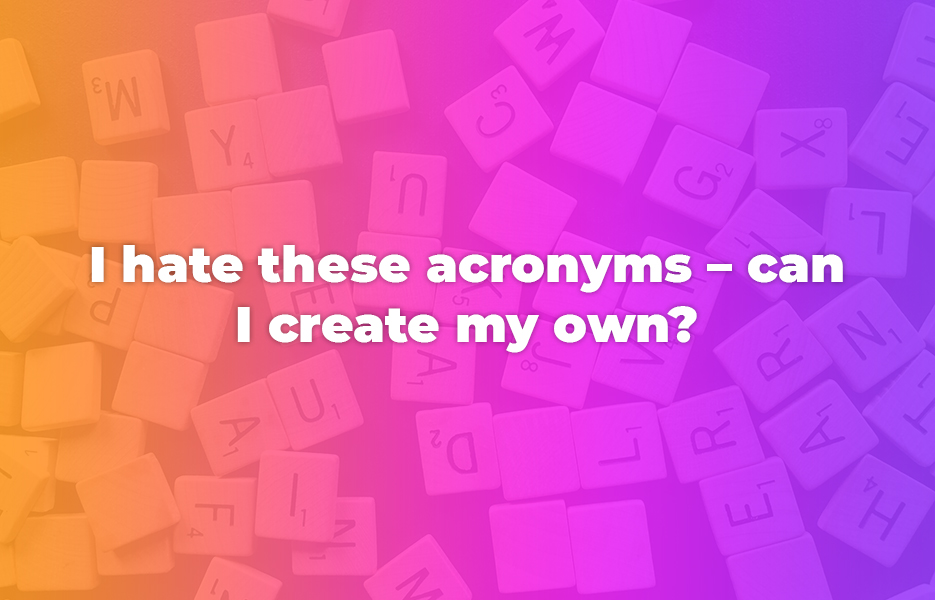
Absolutely! You’re the expert in your business. If these tools don’t work for you or your team, you can adapt them so they work for you best. If you think there are elements of one tool that you can make use of alongside elements of another, and you want to give your personalised tool your own name, feel free. We’re sharing these tools with you because we know they’re successful for many businesses. You don’t have to use any of these tools at all – or you might find another that works for you.
Can you use more than one tool at a time?
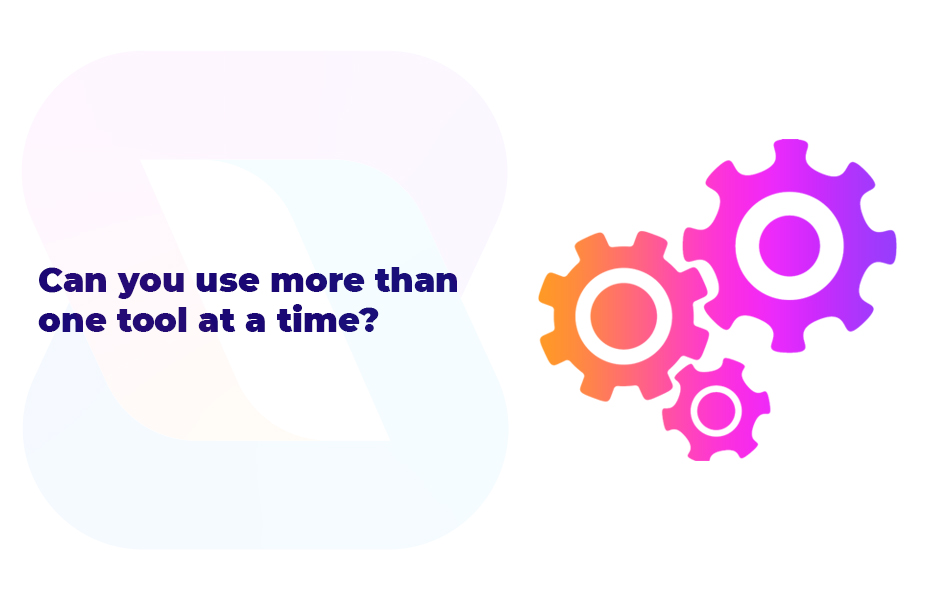
There’s absolutely nothing to stop you, and in some cases, it can be incredibly useful to complete different types of analyses together, or after one another. You know what you want to achieve, and you can identify which tools are the most valuable for your business. You might use a PEST analysis to look at the bigger picture followed by a SWOT analysis, or a different combination – as long as you bear in mind what you want to achieve from each, you’re sure to find value in using more than one tool.
We’re sure there’s no need to say this (because there aren’t many of us that like doing theory – generally we all want to get on with the reality and start earning!) but don’t get bogged down in doing so many analyses that your business ends up being neglected! You need to be getting value from your analyses, not getting stuck on technicalities.
There are a huge array of business techniques that have been developed over the decades. You don’t have to have been to business school to make use of them – as we’ve shown here, many of them are incredibly simple and can be applied to any business without any particular knowledge or prior skills required.
- Use a SWOT analysis for looking at strengths, weaknesses, opportunities and threats to your business or a decision.
- Use a PEST analysis for looking at larger-scale factors – political, economic, sociological and technological – that can impact upon your business, especially when making a decision.
- Use a MOST analysis for setting a mission and the objectives, strategies and tactics that will help your business achieve the mission.
- Use the Six Thinking Hats to gain clarity about a decision or problem you are facing. The hats will help you to look at the issue from different perspectives.
- Use a MoSCoW analysis to prioritise your tasks when you’ve got a time-sensitive project on the go – even if the project is just the end of the day!
- Use the Five Whys when you have a problem to resolve, and you want to find the root cause rather than dealing with the fallout.
Remember, you can apply any of these techniques to any business. If you’re starting your DropShipping business using Avasam, why not use the MOST analysis and a SWOT analysis to get you started? Since you have no upfront costs, there is very little threat to your bank account – just opportunities! Sign up for free here, and find out more about the platform here.

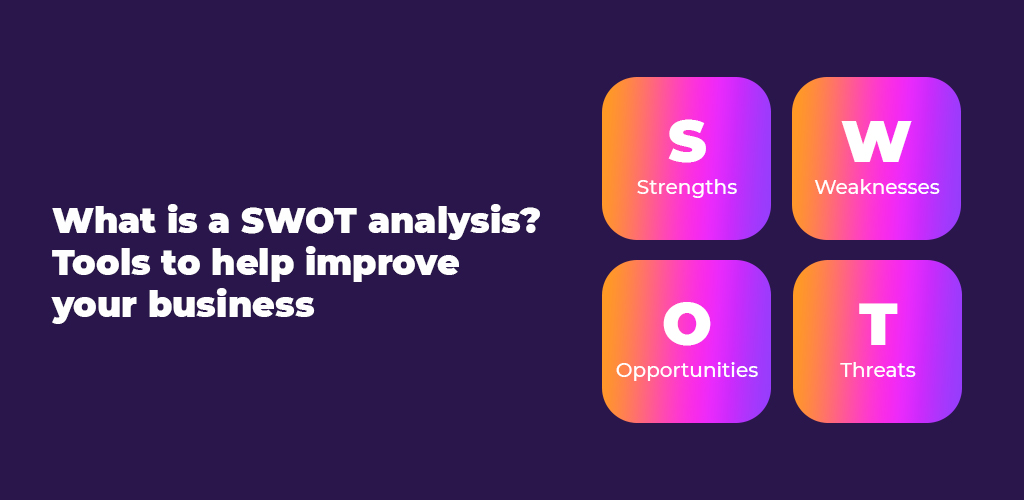






DropShip products from verified suppliers to diversify your inventory and scale your eCommerce business